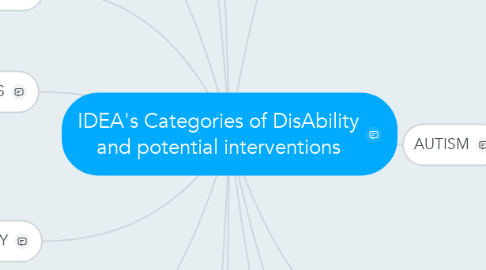IDEA's Categories of DisAbility and potential interventions
by Katie Lootens


1. DEVELOPMENTAL DELAY
1.1. Note: "Developmental Delay is the blanket term for disabilities for students aged 3 - 9.
2. EMOTIONAL DISTURBANCE
2.1. have predictable routines, schedule posted with how long each activity will take
2.2. access to quiet spaces for emotional breaks
2.3. provide language for student to use to ask for help/talk about their emotions
2.4. allow breaks, especially after transitions from things like lunch, recess, or P.E.
2.5. Case Study: Megan (possibly - this would be a good place to start, but further evaluation may reveal a specific learning disability)
3. INTELLECTUAL DISABILITY
3.1. voice-to-text software
3.2. communication boards (pictures students can point to)
3.3. breaking larger ideas into specific tasks
4. MULTIPLE DISABILITIES
4.1. interventions and tools are completely dependent on which disabilities the student has
5. ORTHOPEDIC IMPAIRMENT
5.1. mobility aids (canes, walkers, wheelchairs, etc.)
5.2. footrests for beneath desks
6. OTHER HEALTH IMPAIRMENT
6.1. as with multiple disabilities, "other health impairment" is so broad that it may be difficult to have specific interventions without knowing individual students
7. SPEECH OR LANGUAGE IMPAIRMENT
7.1. paraphrasing back students' responses
7.2. communication books for highly nonverbal/preverbal students
7.3. access to typing (iPad/computer etc).
7.4. Allowing students to pre-record presentations, or have written presentations rather than oral
8. TRAUMATIC BRAIN INJURY
8.1. communication boards
8.2. speech to speech technologies
8.3. orthopedic aids/mobility aids
9. VISUAL IMPAIRMENT INCLUDING BLINDNESS
9.1. Braille writer
9.2. tactile keyboards
9.3. audio books
9.4. audio recording lessons
10. AUTISM
10.1. Noise-reducing headphones
10.2. Clearly and narrowly defined expectations (ex: having student do only a few problems at a time)
10.3. sensory tools (mats, silly putty, fidgets, etc.)
10.4. allowing students to have comfort items (stuffed animal, etc)
10.5. having "break time" areas available
10.6. Case study: my student "Aaron" - we use many of the suggested interventions - for example, he has a stuffed train called Snuggles which he carries around; noise-reducing headphones used to be used extensively but are now used mainly for overwhelming tasks like school assemblies
11. DEAF/BLINDNESS
11.1. Braille writer
11.2. Tactile keyboards
12. DEAFNESS
12.1. written instructions
12.2. video lessons that have closed captioning
12.3. sign language interpreter
13. HEARING IMPAIRMENT
13.1. sound amplification systems (teacher wearing a microphone)
13.2. Including written instructions on everything (including possibly video taping lessons and adding closed-captioning, so student can go back later)
14. SPECIFIC LEARNING DISABILITY (SLD)
14.1. ADD/ADHD
14.1.1. extra time on assignments
14.1.2. noise reducing headphones
14.1.3. quiet rooms for testing
14.1.4. fidget items
14.1.5. extra "movement" breaks
14.2. DYSLEXIA
14.2.1. voice-to-text software
14.2.2. teacher/aide occasionally taking dictation/ allowing parent to take dictation for homework
14.2.3. allowing extra time on assignments, especially testing
14.2.4. oral instructions rather than (or in addition to) written instructions
14.2.5. allowing students to type, rather than handwrite, assignments

